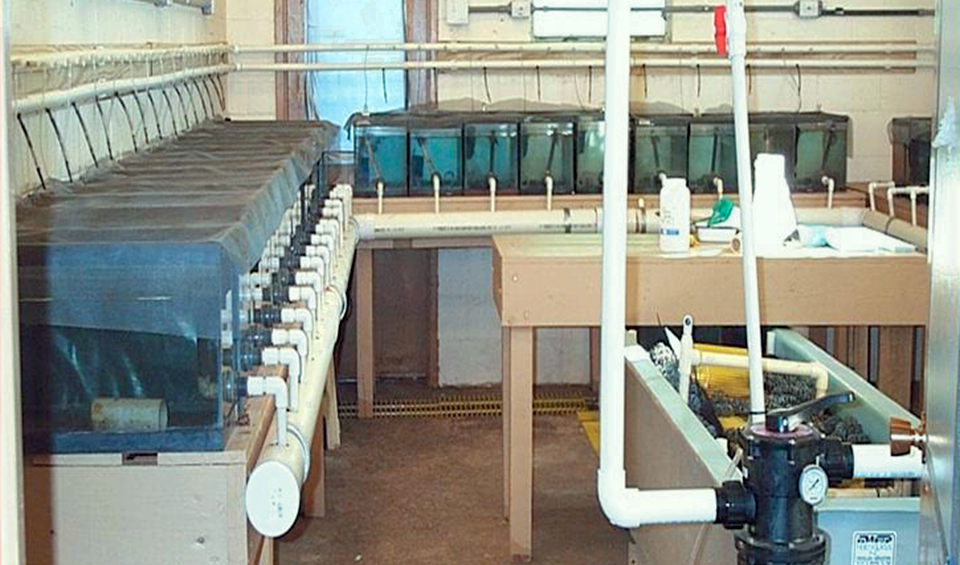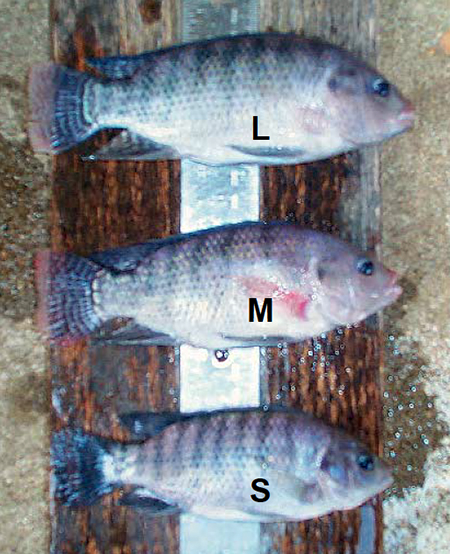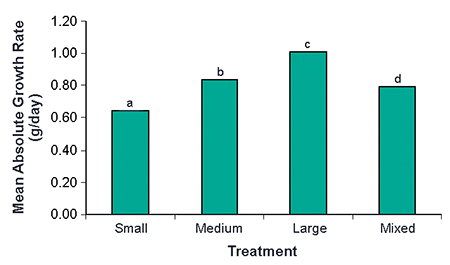Growth rate does not appear to be dependent on size hierarchies

Tilapia producers range from small grow-out facilities that purchase fry from specialized hatcheries to large facilities that produce their own seed. Producers typically stock fry of various ages and sizes into grow-out tanks, net pens, or ponds and maintain them until the fish reach market size. Since producers cannot afford to farm slow-growing fish, they often grade the fish before stocking to allow more effective stocking.
Using ungraded fish can result in under- or overstocking, which in turn can lead to poor feeding practices and increased production costs. In some species, sorting reduces cannibalism and size variability among harvested fish. Furthermore, grading can facilitate feeding by using a smaller range of food particles for each graded group.
The accepted rationale for sorting fish is the expectation that the growth of small fish will improve once large fish are removed. This idea, however, is based on the assumptions that small and large fish have the same, or similar, physiological potentials for growth, and that social interaction is the major cause of growth size differences.
The authors recently tested the effects of size grading tilapia fry before stocking during two studies performed at the Fisheries and Aquaculture Research Station at Auburn University in Alabama, USA.
Experiment 1
In the first experiment, fertilized eggs from one female Nile tilapia (Oreochromis niloticus) were removed, hatched and maintained for 30 days in a 600-liter outdoor tank. The fish were then harvested and graded into three sizes: large, medium, and small (Table 1). Fifteen fish from every size class were stocked into 60-liter aquariums at three replicates per treatment. The treatments were large, medium, small and mixed sizes. The mixed treatment consisted of five fish from every size group stocked together in an aquarium.
Saoud, Growth performance of tilapia sorted by weight at stocking, Table 1
| Treatment | Initial Weight (g) | Final Weight (g) | Final Weight (g) | Condition Index | Coefficient of Variation | Feed- Conversion Ratio |
|---|
Treatment | Initial Weight (g) | Final Weight (g) | Final Weight (g) | Condition Index | Coefficient of Variation | Feed- Conversion Ratio |
|---|---|---|---|---|---|---|
| Small | 2.6a | 13.3a | 90.5a | 1.74a | 0.31a | 1.57a |
| Medium | 3.7b | 18.8b | 97.6ab | 1.88ab | 0.30a | 1.56a |
| Large | 4.9c | 27.0c | 110.5c | 1.94b | 0.26a | 1.57a |
| Mixed | 4.2d | 24.7bc | 106.4bc | 1.86ab | 0.49b | 1.42a |
| Pooled Standard Error | 0.06 | 1.68 | 2.90 | 0.038 | 0.041 | 0.039 |
Fish were maintained for eight weeks and weighed weekly. They were offered a high-protein commercial diet at 5 percent body weight, and water quality was maintained within adequate ranges. At the end of the eight weeks, all fish were harvested and group weighed. Then individual weights and lengths were determined. The sex of the fish in the small and large treatments was identified by visual inspection of the gonads of preserved fish.
Results

When tilapia were size sorted and reared separately, large individuals appeared to maintain their size advantage after eight weeks of culture. The Fulton-type condition index (CI) of the fish in the large treatment was significantly greater than that of the fish in the small treatment, but similar to the CIs in the medium and mixed treatments. The coefficients of variation in weight (CV) in the small, medium, and large treatments were all similar at 0.26 to 0.31 and significantly smaller than the 0.49 CV in the mixed treatment. Feed-conversion ratios (FCRs) were similar among all treatments.
The slopes of the growth versus time curves for the various treatments showed that fish in the large treatment grew faster than the fish in the medium and small treatments. Furthermore, fish in the large treatment grew faster than fish in the other treatments. The sex ratio in the large treatment was significantly different from the sex ratio in the small treatment (P = 0.0067). The average sex ratio in the large treatment was 81.4 percent males and 18.6 percent females, while in the small treatment it was 37.7 percent males and 62.3 percent females.
Experiment 2
In the second experiment, fertilized eggs from three female tilapia were removed, hatched, and maintained for 30 days on a commercial fry feed with testosterone. The sex-reversed fish were then harvested, graded into large, medium and small sizes (Table 2), and stocked as previously described. Fish were maintained in the aquariums for eight weeks, weighed weekly and offered a high-protein commercial diet at 5 percent body weight.
Saoud, Growth performance of testosterone-treated tilapia, Table 2
| Treatment | Initial Weight (g) | Final Weight (g) | Final Length (mm) | Condition Index | Coefficient of Variation | Feed- Conversion Ratio |
|---|
Treatment | Initial Weight (g) | Final Weight (g) | Final Length (mm) | Condition Index | Coefficient of Variation | Feed- Conversion Ratio |
|---|---|---|---|---|---|---|
| Small | 0.9a | 61.3a | 139.69a | 2.15a | 0.31a | 0.88a |
| Medium | 1.2b | 78.8b | 151.67b | 2.22a | 0.26a | 0.88a |
| Large | 1.5c | 95.0c | 160.29c | 2.25a | 0.25a | 0.88a |
| Mixed | 1.1d | 75.8b | 148.71b | 2.22a | 0.33b | 0.87a |
| Pooled Standard Error | 0.005 | 0.81 | 0.46 | 0.15 | 0.013 | 0.003 |
After eight weeks, all fish were harvested and group weighed, with individual weights and lengths also determined. The tilapia were then restocked in 150-liter tanks to accommodate their larger size and maintained on a commercial grow-out diet at 4 percent body weight for five weeks to evaluate further changes in growth.
The growth, survival, FCR, CV and CI of the fish were calculated for both experiments. In the first experiment, differences in sex ratio between the small and large treatments were evaluated by comparing the percentage of males in the two treatments using ANOVA.
Results
The FCRs, CIs, and CV in the sex-reversed experiment were similar among all treatments after 13 weeks of culture (Table 2). Although the CV in weight for the mixed treatment was greater than the other treatments, it was not significantly different. However, growth rate was significantly different among treatments (Fig. 1). Tilapia in the large treatment grew an average of 1.00 grams per day, while fish in the small treatment grew on average 0.65 grams per day. Significant differences in biomass, final weight, and final length were also observed.
Conclusion

Test results indicated the growth rate of tilapia did not appear to be dependent on size hierarchies within a population. Even when tilapia fry were sorted by size, the small fish did not benefit from the assumed reduction in competition. This conclusion was strengthened by the second study, where the tilapia were sex-reversed.
However, based on individual fish weights, when small and large fish were kept together, large fish did tend to reduce the growth of small fish. Dominant fish seemed to control food acquisition and could have modified the appetites of subordinates. In experiment 1, the ratio of males to females was much higher in the large treatment, suggesting that size sorting tilapia is also an effective way to reduce the number of females, which have a slower growth rate than males.
Observations at Auburn University’s Fisheries and Aquaculture Research Station have indicated that small tilapia do not “catch up” with larger siblings even after four months of culture. Based on the experimental results, the authors recommend that hatchery managers grade 30-day-old tilapia fry and discard the smallest one-third of the fish. If producers decide an exclusively male stock is desired, the fish can be sex-reversed with masculinizing feed before they are graded into size classes.
(Editor’s Note: This article was originally published in the December 2003 print edition of the Global Aquaculture Advocate.)
Now that you've finished reading the article ...
… we hope you’ll consider supporting our mission to document the evolution of the global aquaculture industry and share our vast network of contributors’ expansive knowledge every week.
By becoming a Global Seafood Alliance member, you’re ensuring that all of the pre-competitive work we do through member benefits, resources and events can continue. Individual membership costs just $50 a year. GSA individual and corporate members receive complimentary access to a series of GOAL virtual events beginning in April. Join now.
Not a GSA member? Join us.
Authors
-
I. Patrick Saoud
Department of Biology
American University of Beirut
Beirut, Lebanon -
D. Allen Davis, Ph.D.
Department of Fisheries and Allied Aquacultures
Auburn University
Auburn, Alabama, USA -
Luke A. Roy
Department of Fisheries and Allied Aquacultures
Auburn University
Auburn, Alabama, USA
Tagged With
Related Posts

Health & Welfare
10 paths to low productivity and profitability with tilapia in sub-Saharan Africa
Tilapia culture in sub-Saharan Africa suffers from low productivity and profitability. A comprehensive management approach is needed to address the root causes.

Health & Welfare
Commercial demonstration of in-pond raceways
Results of a demonstration project of the In-Pond Raceway System (IPRS) technology in seven tilapia raceways at a commercial farm in Mexico showed the potential for increasing fish production with this environmentally sustainable culture system.

Responsibility
Secchi disk visibility: Correct measurement, interpretation
It would be difficult to find a pond aquaculture worker who has not measured Secchi disk visibility or at least seen someone measure it.

Responsibility
The impact of atmospheric carbon dioxide, alkalinity in freshwater aquaculture
Changes in atmospheric carbon dioxide concentration should have little effect on rising alkalinity concentration in aquaculture systems. Climate change is of greater concern in freshwater aquaculture than is an increase in alkalinity.


